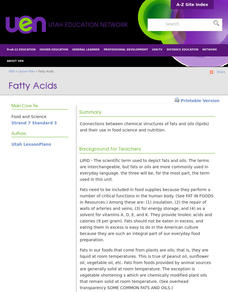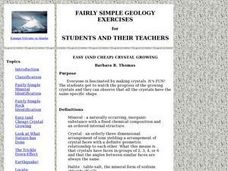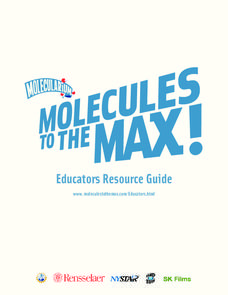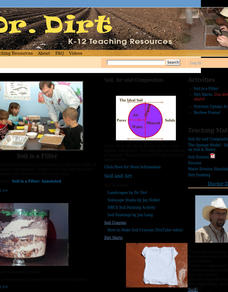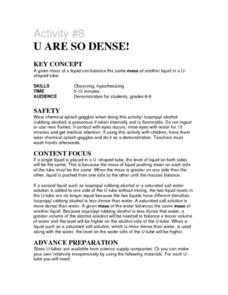Curated OER
Activity #4 Ground Water Model In a Jar
Students devlop a model, which they illustrate a water table and allow for the discussion of common terms and illustrate what those terms mean. They comprehend that a flow rates, removal of contaminants, and the amount of water stored...
Curated OER
Molecular Modeling Activity
Young scholars explore the concept of molecular modeling and differentiate between saturated and unsaturated compounds. In small groups, they identify molecular formulas, complete a chart comparing alkanes, alkenes, and alkynes, and...
Virginia Department of Education
A Crystal Lab
Young chemists grow ionic crystals, metallic crystals, and supersaturated crystals in three different lab experiments. Observing these under a microscope allows pupils to compare the various structures.
Curated OER
Playing With Polymers
Students explore the world of polymers. In this chemistry activity, students make polymers and observe their properties. Follow-up questions and extension activities are included.
Cornell University
Polymers: Making Silly Putty
Putty is proof that learning can be fun! Share the wonderful world of polymers with your class through an experiment. Young scientists create their own silly putty, then examine its properties.
Curated OER
Organic Chemistry I: Problem Set 17-alkenes
In this organic chemistry of alkenes worksheet, students name and write the chemical formulas for 12 alkenes and then complete 3 short answer questions about the saturation of alkene compounds.
Curated OER
Fatty Acids
Identify the properties of fats and lipids. Compare the properties of saturated and unsaturated fatty acids Identify foods containing triglycerides and identify which foods contain saturated and unsaturated fat Discuss the function of...
Curated OER
Changes in Nature
Fifth graders identify the chemical and physical changes in the water cycle, carbon cycle, and the effects of weathering. They analyze the periodic table, and observe how vinegar reacts with limestone in a chemical reaction that causes...
Curated OER
EASY (AND CHEAP) CRYSTAL GROWING
Students grow salt crystals by making a saturated solution of table salt and let the solution sit around and evaporate.
Curated OER
Indicator Sponge A Discrepant Event Demonstration
Students explore the use of acid and base pH indicators. The teacher saturates an indicator sponge with congo red solution. Afterwards, the sponge is placed in a blue base solution. Students observe that the blue sponge actually turns...
Curated OER
Disposable Diaper Comparison and Mystery Powder Identification
Students investigate which diaper is the most absorbent. In this chemistry lesson, students calculate how much water is absorbed by diapers. They identify an unknown powder based on physical and chemical properties.
Rensselaer Polytechnic Institute
Molecules to the Max!—Educators Resource Guide
From molecules to nanotubes, an engaging unit explores the world of tiny science. Fifteen hands-on experiments and lessons engage young scientists as they learn chemistry. Discussions, worksheets, and data analysis reinforce the concepts...
Curated OER
WS 10.1 Solubility Product
In this solubility worksheet, students find the solubility product constants for four compounds and use solubility product constants to determine solubility data of four compounds.
Curated OER
The Hazardous Waste Dilemma
Students discuss the characteristics of a hazardous waste site and how they can cause health problems to humans. In groups, they research the various ways to deal with the hazardous materials and read recent articles on the subject. To...
Curated OER
Ice Energy
Students explore how chemicals change water. In this chemical change lesson, students participate in an experiment to observe how salt effects ice and how ice cream freezes.
Curated OER
Water Conservation/ Pollution: Why is the Water Running?
Students consider water conservation and chemical pollution of water. In this water use instructional activity, students discover how water towers and dams are used to take water to desired locations. Students also discuss the effects of...
Curated OER
Soil and Water
Students study soil and how particle and pore size affect water movement. In this soil lesson students complete a lab activity to investigate pore saturation and sponge like behavior.
Curated OER
Activity #8 U Are So Dense!
Students watch as the teacher demonstrates: if a single liquid is placed in a U-shaped tube, the level of liquid on both sides are the same. When the mass is greater on one side than the other, liquid is pushed from one side to the...
Curated OER
A Solution for Precipitation
Students predict the product of chemical reaction using the solubility rules. In this chemistry lesson, students balance ionic equation. They perform a lab to check if their predicted products are correct.
Curated OER
Swinging Electrons
Students illustrate paramagnetic and diamagnetic differences due to the unfilled and filled valence shells. They prepare saturated solutions and place into test tubes.
Curated OER
Growing Crystals
Pupils are introduction to the cause and effect of a chemical reaction between water, mucilage glue, and magnesium sulfate as they form crystals.
Curated OER
Physiology Activity Perception and Behavior
Students conduct an experiment to determine a fly's ability to detect sugar, its behavioral response, how a previous experience may alter the response, if a fly can be tricked, and how human sensitivity compares to a fly.
Curated OER
The Alkaline Earth Metals
Students investigate the characteristics of alkaline earth metals. In this alkaline earth metals lesson plan, students experiment with a variety of alkaline earth metal compounds and perform tests to observe their properties. Students...
Carnegie Mellon University
Ocean Acidification
After brainstorming what they know about ocean acidification, youngsters place eggs in acid to determine the effects on calcium-containing organisms, and add carbon dioxide to solutions with sea shell material to discover the impact on...






